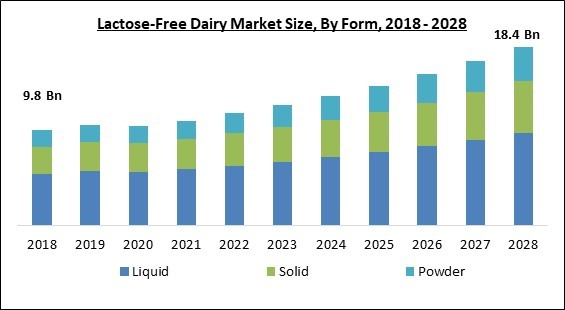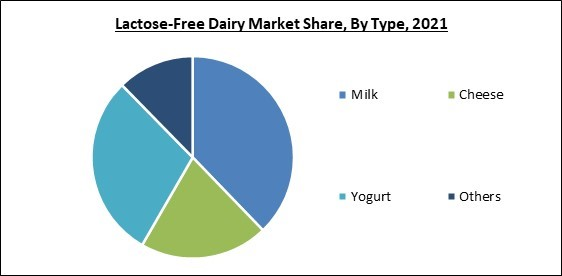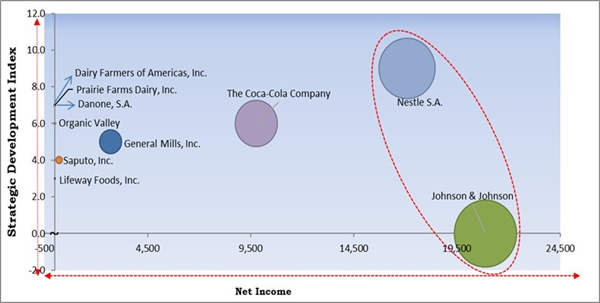The Global Lactose-Free Dairy Market size is expected to reach $18.4 billion by 2028, rising at a market growth of 8.1% CAGR during the forecast period.
Glucose & galactose are formed when lactose is broken down in lactose-free milk, which are the two simple sugars that provide lactose-free milk a sweeter flavor than ordinary milk. Some people find lactose, a type of sugar included in milk, difficult to digest. Lactase is used with ordinary cow milk to create lactose-free dairy products.
An individual's small intestine produces the enzyme lactase on its own, which is in charge of breaking down lactose in the body. It is a commercially accessible enzyme that can be isolated from molds like Aspergillus Niger and Aspergillus oryzae as well as yeasts like Kluyveromyces lactic and fragile. Lactose-free dairy products are similar to regular milk and other milk products on the market in terms of flavor, texture, and nutritional value.
Market participants have been compelled to concentrate on strong branding and enhanced advertising as a result of the fierce competition in the lactose-free dairy market. Gaining consumer exposure to the products through branding and advertising is essential. Players are therefore engaging in profitable marketing strategies to entice customers.
Additionally, a rise in the number of lactose-free dairy product launches that are supplemented with vitamins and minerals draws customers to the product. Consumers can recognize the chemicals used in a product and the benefits they can obtain from consuming it due to strong branding by market participants and the implementation of clear labels on the items.
Manufacturers are aiming to make products with more protein components to meet the gradual shift in taste as well as the preference of consumers to maintain a better diet in order to drive the market for lactose-free dairy products. The market for dairy products without lactose is therefore anticipated to grow over the projected period.
The major strategies followed by the market participants are Product Launches. Based on the Analysis presented in the Cardinal matrix; Johnson & Johnson and Nestle S.A. are the forerunners in the Lactose-Free Dairy Market. Companies such as The Coca-Cola Company, General Mills, Inc. and Dairy Farmers of Americas, Inc. are some of the key innovators in Lactose-Free Dairy Market.
The market research report covers the analysis of key stake holders of the market. Key companies profiled in the report include Dairy Farmers of Americas, Inc., Danone, S.A. (Sofina Group), General Mills, Inc., Lifeway Foods, Inc., Nestle S.A., Saputo, Inc., The Coca-Cola Company, Organic Valley, Johnson & Johnson, and Prairie Farms Dairy, Inc.
Glucose & galactose are formed when lactose is broken down in lactose-free milk, which are the two simple sugars that provide lactose-free milk a sweeter flavor than ordinary milk. Some people find lactose, a type of sugar included in milk, difficult to digest. Lactase is used with ordinary cow milk to create lactose-free dairy products.
An individual's small intestine produces the enzyme lactase on its own, which is in charge of breaking down lactose in the body. It is a commercially accessible enzyme that can be isolated from molds like Aspergillus Niger and Aspergillus oryzae as well as yeasts like Kluyveromyces lactic and fragile. Lactose-free dairy products are similar to regular milk and other milk products on the market in terms of flavor, texture, and nutritional value.
Market participants have been compelled to concentrate on strong branding and enhanced advertising as a result of the fierce competition in the lactose-free dairy market. Gaining consumer exposure to the products through branding and advertising is essential. Players are therefore engaging in profitable marketing strategies to entice customers.
Additionally, a rise in the number of lactose-free dairy product launches that are supplemented with vitamins and minerals draws customers to the product. Consumers can recognize the chemicals used in a product and the benefits they can obtain from consuming it due to strong branding by market participants and the implementation of clear labels on the items.
Manufacturers are aiming to make products with more protein components to meet the gradual shift in taste as well as the preference of consumers to maintain a better diet in order to drive the market for lactose-free dairy products. The market for dairy products without lactose is therefore anticipated to grow over the projected period.
COVID-19 Impact Analysis
The lactose-free market is one of the markets that has suffered because of the COVID-19 outbreak. Business demands have changed to liquidation methods and stock organization as a result of post-pandemic client preference shifts, with consumption at a standstill and inventory building up in stockrooms. It was one of the most severely impacted businesses by the pandemic due to the combined effect of outlet closures as well as balanced results due to the fast deteriorating financial position. Also, because of the strict lockdown measures put in place by the government, the COVID-19 pandemic afflicted both farmers and employees.Market Growth Factors
Rising Prevalence Of Lactose Intolerance, Awareness, And Self-Diagnosis
Lactose, the sugar in milk, cannot be fully absorbed by those who have lactose intolerance. They can witness diarrhea, gas, and bloating as a result of consuming dairy products. The illness, which is also termed lactose malabsorption, is normally harmless, however, its symptoms can be irritating. Lactose intolerance is typically caused by insufficient amounts of the enzyme lactase, which is produced in the small intestine. The number of lactose intolerant people is rising all over the globe.Increasing Popularity Of Social Media Marketing
Some of the reasons that are fueling the industry, even more, include extensive celebrity and athlete marketing campaigns to promote vegetarianism as a healthy lifestyle choice and the simplicity of product accessibility through an abundance of online retail channels. As a result of the growing penetration of the internet along with the increased number of people using various social media platforms, people are becoming more aware regarding the issues such as lactose intolerance as well as the availability of lactose free substitutes.Market Restraining Factors
The High Cost Of Lactose-Free Ingredients
When making lactose-free milk, the milk must be pasteurized using the ultra-high temperature (UHT) method in order to extend its shelf life and improve the consistency of the milk while creating lactose-free milk. Milk is processed with lactase enzymes, which break down the complicated lactose disaccharide into two simple sugars, known as glucose and (monosaccharide’s) galactose, to transform regular milk into lactose-free milk.Type Outlook
Based on type, the lactose-free dairy market is segmented into milk, cheese, yogurt and others. The yogurt segment acquired a substantial revenue share in the lactose-free dairy market in 2021. If someone is looking for a dairy substitute because of a preference or a lactose allergy, dairy-free yogurt is a good option because it still has a respectable quantity of healthy fats while being lactose-free. Almonds, coconut, cashews, flaxseed, soy, or oats are the most common bases for dairy-free yogurts that are available in supermarkets.Form Outlook
On the basis of form, the lactose-free dairy market is divided into solid, liquid and powder. In 2021, the liquid segment held the highest revenue share in the lactose-free dairy market. The most prevalent form of lactose-free dairy on the market is liquid. The most liquid form of milk is consumed across, and consumers often include it in their diets. Also, a large number of people consume flavored lactose free milk as they contain less sugar which is propelling market growth in this segment.Distribution Channel Outlook
By distribution channel, the lactose-free dairy market is fragmented into hypermarkets/supermarkets, convenience stores, online channels and others. In 2021, the hypermarkets/supermarkets segment generated the maximum revenue share in the lactose free dairy market. Supermarkets and hypermarkets give customers the convenience of shopping for a variety of items under one roof. Customers benefit greatly from shopping at hypermarkets and supermarkets because there is a greater selection of lactose-free dairy products available at lower prices, salespeople are on hand to help, and checkout is simple. During the projection period, these benefits are anticipated to fuel the market growth in this segment.Regional Outlook
Region wise, the lactose-free dairy market analyzed across North America, Europe, Asia Pacific and LAMEA. The Europe region led the lactose free dairy market with the largest revenue share in 2021. The market dominance of lactose-free dairy products in Europe is largely attributable to customers' extensive product awareness and rising consumption as a result of the product's favorable health effects. Other factors such as the large number of vendors across the region providing lactose-free dairy products are also supporting regional market growth for lactose free dairy market.Cardinal Matrix - Lactose-Free Dairy Market Competition Analysis
The major strategies followed by the market participants are Product Launches. Based on the Analysis presented in the Cardinal matrix; Johnson & Johnson and Nestle S.A. are the forerunners in the Lactose-Free Dairy Market. Companies such as The Coca-Cola Company, General Mills, Inc. and Dairy Farmers of Americas, Inc. are some of the key innovators in Lactose-Free Dairy Market.
The market research report covers the analysis of key stake holders of the market. Key companies profiled in the report include Dairy Farmers of Americas, Inc., Danone, S.A. (Sofina Group), General Mills, Inc., Lifeway Foods, Inc., Nestle S.A., Saputo, Inc., The Coca-Cola Company, Organic Valley, Johnson & Johnson, and Prairie Farms Dairy, Inc.
Strategies deployed in Lactose-Free Dairy Market
; Partnerships, Collaborations and Agreements:
- Jul-2020: Coca-Cola entered into a partnership with Boardwalk Frozen Treats, a sales, marketing, manufacturing, and distribution partner for national ice cream brands. The product offers seven flavors: vanilla, chocolate, cookies & cream, chocolate peanut butter, double fudge brownie, java chip, and mint chip.
- Jun-2020: General Mills came into partnership with Foremost Farms and Understanding. Through this partnership, the companies aimed to pilot regenerative practices as well as support participating dairy farmers. This partnership is expected to ensure that the transition to regenerative practices is expected to be beneficial to General Mills' dairy partners and improve the overall health of their farms.
; Product Launches and Product Expansions:
- Jul-2022: Danone released the latest Dairy & Plants Blend baby formula. This launch focused on fulfilling parents' demand for feeding options suitable for vegetarian, flexitarian, and plant-based diets along with addressing their baby’s specific nutritional requirements. The latest Dairy & Plants Blend recipe combines the advantages of Danone’s trusted dairy-based baby formulas with more plant nutrition that includes carefully selected plant proteins, fats, and fibers. It is the industry’s first blended baby formula for healthy babies, which contains more than half (60%) of the plant-based protein.
- Mar-2022: Organic Valley released Creamers, a new premium organic creamer available in french vanilla and sweet cream flavors. The company aimed at providing customers with creamers that have lactose-free, smooth, creamy taste and no artificial ingredients.
- Nov-2021: General Mills released Bold Cultr, an animal-free dairy cheese brand. It’s a big deal that actual dairy proteins can be produced without a cow and From this launch, the company aimed at meeting the consumer need for animal-free substitutes which could fulfill cheese demand.
- Sep-2021: Lifeway Foods introduced the latest plant-based Lifeway Oat line. Also, the latest Chocolate Kefir flavor is expected to be launched at the upcoming Natural Products Expo East 2021. Through this launch, the company is expected to be able to expand its portfolio of probiotic beverages beyond their best-selling kefir to include a dairy-free, certified vegan option that offers customers probiotic advantages to help support a healthy gut and immunity.
- May-2021: Nestlé released Wunda, a new pea-based beverage. The product is expected to first be introduced in France, the Netherlands, and Portugal, and then in other European markets. Under this launch, Wunda offers most cereal-, nut- or pea-based milk alternatives that have a specific taste, are less in protein or don’t mix or foam well in hot beverages. This shows customers might require two or three plant-based options for different uses until now.
- Apr-2021: Nestlé expanded their existing brand Milo by adding plant-based versions. This latest version substitutes the milk in the original recipe with almond and soy, but the other two core ingredients - malt and cocoa stay the same. From this expansion, the company focused on providing customers with on-trend alternatives in formats they want.
- Sep-2020: Nestlé expanded its range of dairy alternatives by introducing a plant-based Nesquik drink in Europe which consists of less sugar in comparison to the existing version. The latest ready-to-drink beverage is expected to initially go on the market in Spain, Portugal, and Hungary before being rolled out in other European countries. This launch is expected to address Nestlé’s growing focus on authentic plant-based food and beverages as customers look at different ways to enjoy and balance their protein intake and lower the environmental footprint of their diets.
; Acquisitions and Mergers:
- May-2021: Saputo took over Bute Island Foods, an innovative manufacturer, marketer, and distributor of a variety of dairy alternative cheese products. The acquisition is expected to allow the company to accelerate its growth in this region worldwide, putting innovation at the forefront of its priorities.
- Mar-2021: Danone took over Follow Your Heart, Los Angeles-based vegan dairy maker by purchasing Earth Island shares. This acquisition is expected to support the company's growth in plant-based beverages, yogurt alternatives, and creamers, further accelerating the growth of Danone's North American plant-based business.
- Apr-2020: Prairie Farms Dairy acquired Dean Foods Company, an American food, and beverage company. This acquisition is expected to enable the company to grow from 44 (processing) plants to 52 plants, growing from 16 states’ distribution to 20 states’ distribution.
- Jan-2020: Coca-Cola completed the acquisition of Fairlife, an American brand of ultra-filtered milk distributed in Canada. From this acquisition, the company focused on diversifying its portfolio beyond its iconic sodas. Despite facing challenges with the brand’s reputation in 2019, value-added dairy has been an expanding sector in the U.S. and one that could help Coca-Cola going forward.
Scope of the Study
Market Segments Covered in the Report:
By Form
- Liquid
- Solid
- Powder
By Type
- Milk
- Cheese
- Yogurt
- Others
By Distribution Channel
- Hypermarkets/Supermarkets
- Convenience Stores
- Online Channels
- Others
By Geography
- North America
- US
- Canada
- Mexico
- Rest of North America
- Europe
- Germany
- UK
- France
- Russia
- Spain
- Italy
- Rest of Europe
- Asia Pacific
- China
- Japan
- India
- South Korea
- Singapore
- Malaysia
- Rest of Asia Pacific
- LAMEA
- Brazil
- Argentina
- UAE
- Saudi Arabia
- South Africa
- Nigeria
- Rest of LAMEA
Key Market Players
List of Companies Profiled in the Report:
- Dairy Farmers of Americas, Inc.
- Danone, S.A. (Sofina Group)
- General Mills, Inc.
- Lifeway Foods, Inc.
- Nestle S.A.
- Saputo, Inc.
- The Coca-Cola Company
- Organic Valley
- Johnson & Johnson
- Prairie Farms Dairy, Inc.
Unique Offerings from the Publisher
- Exhaustive coverage
- The highest number of Market tables and figures
- Subscription-based model available
- Guaranteed best price
- Assured post sales research support with 10% customization free
Table of Contents
Chapter 1. Market Scope & Methodology
Chapter 2. Market Overview
Chapter 3. Competition Analysis - Global
Chapter 4. Global Lactose-Free Dairy Market by Form
Chapter 5. Global Lactose-Free Dairy Market by Type
Chapter 6. Global Lactose-Free Dairy Market by Distribution Channel
Chapter 7. Global Lactose-Free Dairy Market by Region
Chapter 8. Company Profiles
Companies Mentioned
- Dairy Farmers of Americas, Inc.
- Danone, S.A. (Sofina Group)
- General Mills, Inc.
- Lifeway Foods, Inc.
- Nestle S.A.
- Saputo, Inc.
- The Coca-Cola Company
- Organic Valley
- Johnson & Johnson
- Prairie Farms Dairy, Inc.











